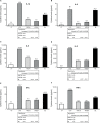Water-soluble egg membrane enhances the immunoactivating properties of an Aloe vera-based extract of Nerium oleander leaves
- PMID: 27843333
- PMCID: PMC5098409
- DOI: 10.2147/CCID.S114471
Water-soluble egg membrane enhances the immunoactivating properties of an Aloe vera-based extract of Nerium oleander leaves
Abstract
Objective: To evaluate a blend of two natural ingredients on immune parameters relevant for their current topical use and potential support of microcirculation in skin tissue.
Materials and methods: A blend (BL) of Aloe vera-based Nerium oleander extract (NAE-8i, oleandrin-free) and hydrolyzed water-soluble egg membrane (WSEM) was applied to human whole-blood cultures for 24 hours, with each separate ingredient serving as a control. Immune-cell subsets were analyzed for expression levels of the activation markers CD69 and CD25. Culture supernatants were analyzed for cytokines, chemokines, and immunoregulating peptides.
Results: BL increased CD69 expression on lymphocytes, monocytes, and CD3-CD56+ natural killer cells, and CD25 expression on natural killer cells. The number of CD69+CD25+ lymphocytes increased in cultures treated with BL and the separate ingredients. BL triggered production of multiple cytokines and chemokines, where CC chemokines MIP1α and MIP3α, as well as cytokines involved in wound healing - Groα, Groβ, ENA78, and fractalkine - reached levels manyfold above treatment with either NAE-8i or WSEM alone.
Conclusion: Data on BL showed that WSEM strongly enhanced NAE-8i's effects on immunoactivation in vitro. This has potential relevance for support of immunity in skin tissue, including antibacterial and antiviral defense mechanisms, wrinkle reduction, and wound care.
Keywords: chemokines; cytokines; leukocyte activation.
Conflict of interest statement
KFB and GSJ are employed by NIS Labs, an independent contract-research laboratory specializing in natural product research. RAN serves as chief science officer for Nerium Biotechnology Inc, the sponsor of this study. The authors report no other conflicts of interest in this work.
Figures






References
-
- Thelan M, Stein JV. How chemokines invite leukocytes to dance. Nat Immunol. 2008;9(9):953–959. - PubMed
-
- Tan SY, Roediger B, Weninger W. The role of chemokines in cutaneous immunosurveillance. Immunol Cell Biol. 2015;93(4):337–346. - PubMed
-
- Serhan CN. Resolution phase of inflammation: novel endogenous anti-inflammatory and proresolving lipid mediators and pathways. Annu Rev Immunol. 2007;25:101–137. - PubMed
-
- Ward PA. Acute and chronic inflammation. In: Serhan CN, Ward PA, Gilroy DW, editors. Fundamentals of Inflammation. New York: Cambridge University Press; 2010. pp. 1–16.
LinkOut - more resources
Full Text Sources
Other Literature Sources
Research Materials

